Romania – Northeast (Iaşi, Bacău, Botoşani, Neamţ, Suceava) June 8-10, 2019
It was a long 5½ hour drive from Tulcea on the Danube Delta to just south of Iasi. All was on 2-lane roads that improved from narrow patched pavement to wide and smooth for the last 140kms. I passed through basically flat agricultural land just to he west of the Danube which I finally crossed.
In retrospect I would have done much better to drive to Piatra Neumt and saved the 130km drive east from Iasi to get there and see Iasi at the end of the NE section.
Mihai Eminescu Monument, Onesti.
About 10kms south of Iaşi, this is a black stone bust of Eminescu on a 2m white marble pedestal. A wreath of laural leaves is across his chest. It sits in an amazing stand of 13 huge trees called plopii in Romanian. On one of the trees is a small sign “Ecomonument, Plopii fara sot”. The writing on the pedestal reads:
Pe lângâ plopii fără sot
Adesea am trecut;
Mă cunosteau vecinit toti-
Tue nu m-ai cunoscute
M Eminescu
Mihai Eminescu (1850 – 1889), born Mihail Eminovici in Botoșani was a Romantic poet, novelist, and journalist, generally regarded as the most famous and influential Romanian poet, as well as the first modern poet in Romanian literature. Eminescu was an active member of the Junimea literary society and worked as an editor for the newspaper Timpul (“The Time”), the official newspaper of the Conservative Party (1880–1918). His poetry was first published when he was 16 and he went to Vienna to study when he was 19. The poet’s manuscripts, containing 46 volumes and approximately 14,000 pages, were offered by Titu Maiorescu as a gift to the Romanian Academy during the meeting that was held on 25 January 1902. Notable works include Luceafărul (The Vesper/The Evening Star/The Lucifer/The Daystar), Odă în metru antic (Ode in Ancient Meter), and the five Letters (Epistles/Satires). In his poems he frequently used metaphysical, mythological and historical subjects.
IAŞI (pop 475,000)
Iași also referred to as Jassy or Iassy is the second largest city in Romania, and the seat of Iași County. Located in the historical region of Moldavia, Iași has traditionally been one of the leading centres of Romanian social, cultural, academic and artistic life. The city was the capital of the Principality of Moldavia from 1564 to 1859, then of the United Principalities from 1859 to 1862, and the capital of Romania from 1916 to 1918.
Known as The Cultural Capital of Romania, Iași is a symbol in Romanian history. The historian Nicolae Iorga said “There should be no Romanian who does not know of it. Still referred to as The Moldavian Capital, Iași is the main economic and business centre of the Moldavian region of Romania. In December 2018, Iași was officially declared Historical capital of Romania.
At the 2011 census, the city proper had a population of 290,422 (making it the fourth most populous in Romania at the time). With 474,035 residents (as of 2015), the Iași urban area is the second most populous in Romania (after Bucharest),[5] whereas more than 500,000 people live within its peri-urban area.
Home to the oldest Romanian university and to the first engineering school, Iași is one of the most important education and research centres of the country, and accommodates over 60,000 students in 5 public universities. The social and cultural life revolves around the Vasile Alecsandri National Theater (the oldest in Romania), the Moldova State Philharmonic, the Opera House, the Iași Athenaeum, a famous Botanical Garden (the oldest and largest in Romania), the Central University Library (the oldest in Romania), the high quality cultural centres and festivals, an array of museums, memorial houses, religious and historical monuments. The city is also known as the site of the largest Romanian pilgrimage which takes place each year, in October.
On the pedestrian street behind the nice yellow church are several glass cubicles crammed with books.
Unirii Museum (Unity Museum). The palace was built in 1806 and hosted the first meeting of the Unionists. It was the residence of Prince Alexandre Ion Cuza from 1859-61 and King Ferdinand I from 1917-18. The museum was founded 1n 1937 and in 1959 became the Musuem of the Union commemorating the centenary of Romania’s birth. The apartments are restored to the period of the Prince. The highlight is the 6 massive atlases. 10 Lei, 5 reduced.
Natural History Museum. I get tired of all the stuffed animals often in poor dioramas. And the rocks, 10 Lei, 5 reduced.
Mihail Kogalniceanu Museum. (1817 – 1891) was a Moldavian, later Romanian liberal statesman, lawyer, historian and publicist; he became Prime Minister of Romania on October 11, 1863, after the 1859 union of the Danubian Principalities under Domnitor Alexandru Ioan Cuza, and later served as Foreign Minister under Carol I. He was several times Interior Minister under Cuza and Carol. A polymath, Kogălniceanu was one of the most influential Romanian intellectuals of his generation. While serving as a professor at Academia Mihăileană, Kogălniceanu came into conflict with the authorities over his Romantic nationalist inaugural speech of 1843. He was the ideologue of the abortive 1848 Moldavian revolution, authoring its main document, Dorințele partidei naționale din Moldova.
Following the Crimean War (1853–1856), with Prince Grigore Alexandru Ghica, Kogălniceanu was responsible for drafting legislation to abolish Roma slavery. He successfully promoted Cuza, his lifelong friend, to the throne. Kogălniceanu advanced legislation to revoke traditional ranks and titles, and to secularize the property of monasteries. His efforts at land reform resulted in a censure vote, leading Cuza to enforce them through a coup d’état in May 1864. However, Kogălniceanu resigned in 1865, following his own conflicts with the monarch. A decade after, he helped create the National Liberal Party, before playing an important part in Romania’s decision to enter the Russo-Turkish War of 1877–1878—a choice which consecrated her independence. He was also instrumental in the acquisition, and later colonization, of Northern Dobruja region. During his final years, he was a prominent member and one-time President of the Romanian Academy.
Next door in nice park was another museum to Petri Poni (1841-1925) and Padu Cernatescu (1874-1958) two academics and professors who both lived here. Poni was also the mayor of Iași. 5Lei
Trei Ierarchi Monastery (Three Holy Hierarhs Monastery). Wow! The exterior of this church is other worldly – the entire building is covered in unique stone lace carvings, Persian vases, Georgian and Armenian geometrics, flowering lilies and a twisted ribbon on black marble, a symbol of the infinite and divinity.
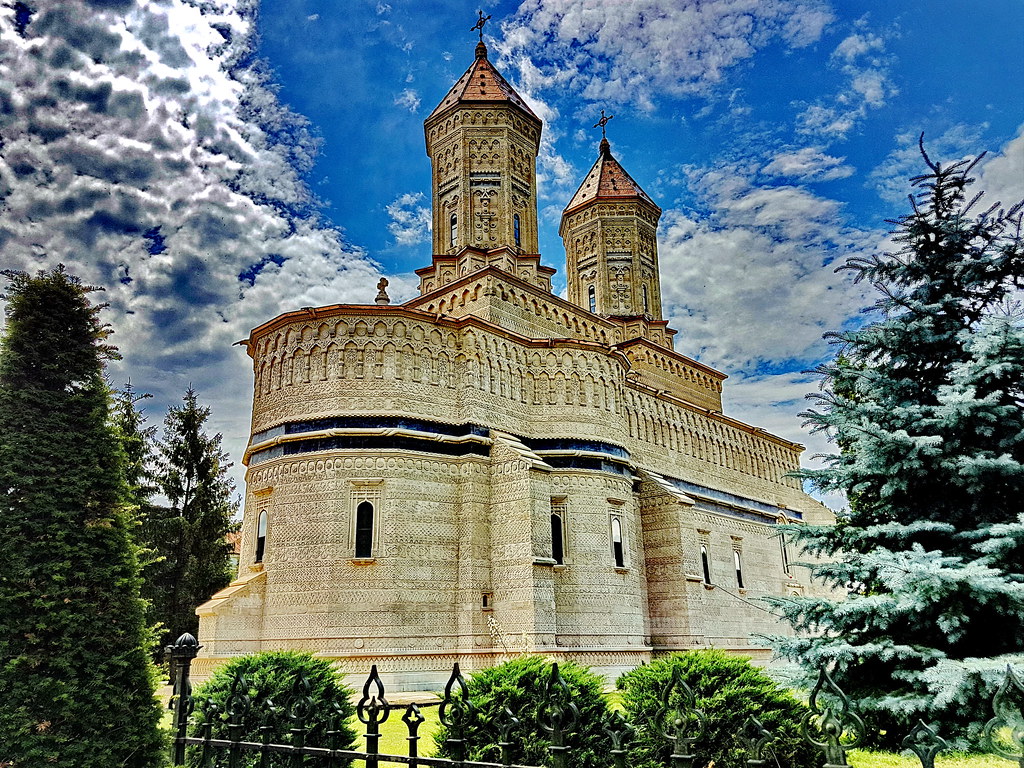

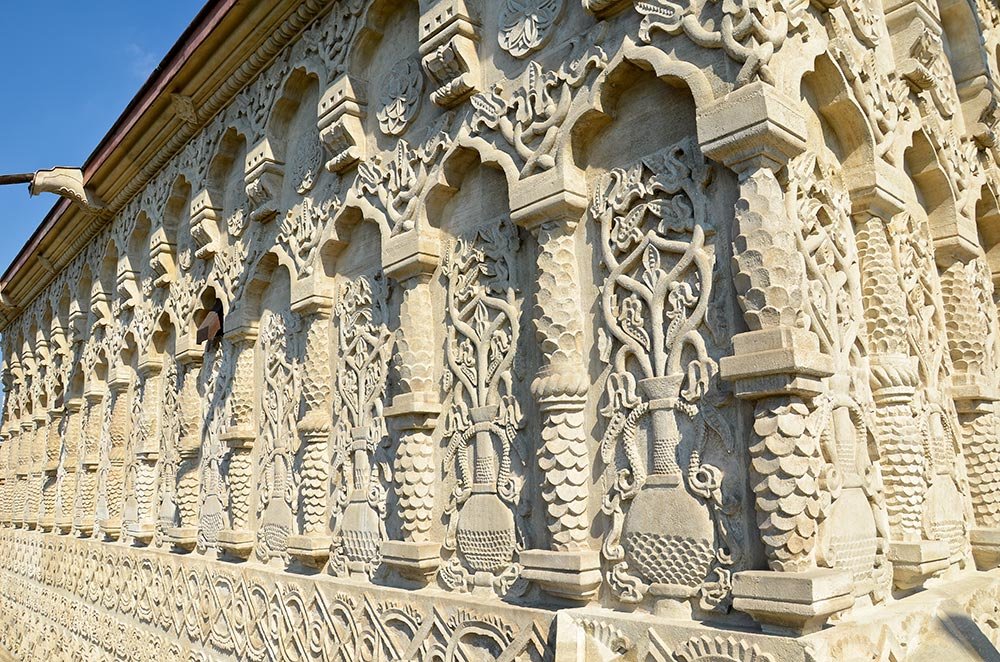
The monastery was founded in 1637-39 by Prince Vasile Lupu, was devastated by the Tartars in 1656, set on fire twice in 1636 (supposedly so the Turks could get all the gold embellishing the façade) and in 1927, and suffered through 6 earthquakes in the 1700s. Totally restored in 1882-87 and painted in 1898, the frescoes are opulent gilt, the 1639 iconostasis made in Moscow gilt and the gilt chairs have ivory and bronze inlays. The relics of St Paraschive the New were brought here from Constantinople in 1850 and the church has been a site of pilgrimage since. The Three Hierarchs refers to the 3 whose tombs are here: Vaile Lupe, Alexandre Ioan Cuza (1820-73, the ruler of the United Romanian Principalities) and Prince Cantemu (body repatriated in 1935). Since 1994, it has regained monastery status and now has several monks. Free
There was also a Mihai Eminescu statue in the yard of the church.
Palace of Culture. This huge monumental palace built in 1906-25 fronts the entire main square. The yellow stone is embellished with white marble crests and balconies. A large clock tower fronts the façade. Full of marble columns with Corinthian capitals, stairways and floors, it is opulent inside. The buildings large concert hall hosts recitals and concerts and the museum had interesting exhibits called “Olfactory” with perfumes and graphics by Christopher Castle. 12 Lei, 6 reduced.
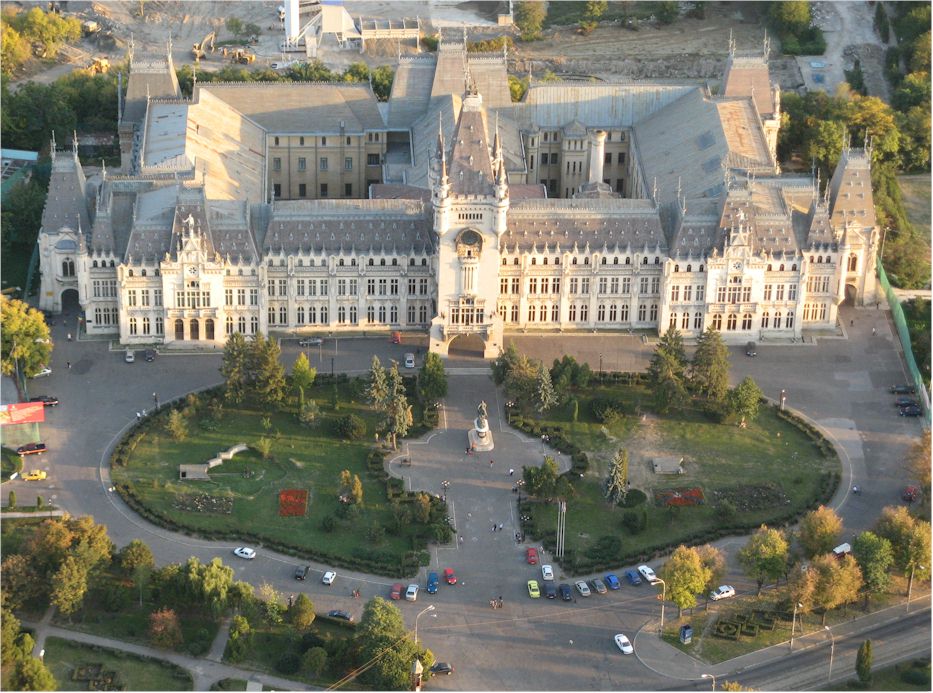
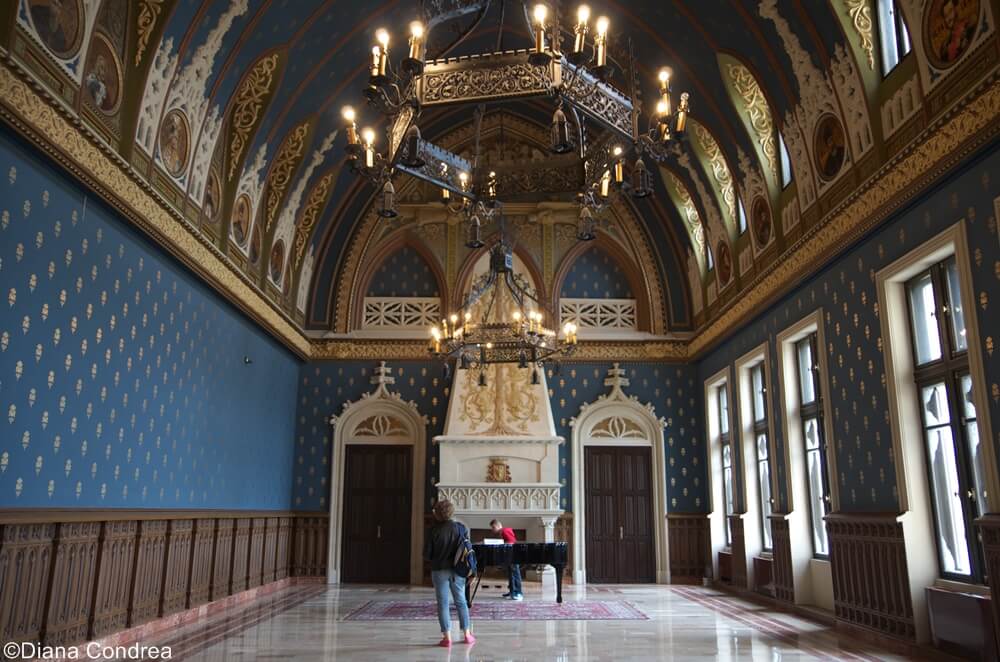
Palais Mall. A huge sunken garden is below the Palace of Culture and backed by this shopping mall, a 2-story affair. A rock concert with several microbreweries and a great food selection was going on in the gardens. Restaurants line them at the back and sides. The large food court has nice balcony seating.
Botanic Garden. Dating from 1856, this is an ornamental gardens with many well trimmed hedges and a large green house with tropical plants. The stupendous rose gardens and ornamental trees were in full bloom. 10 Lei, 5 reduced
Hala Centrala Market. Called MCM Centre, I was reassured that this was the central market hall but remained unconvinced. A new 3-story building, the bottom has a small Carrefour food market and a few other stores. The upper floors are MCM Construction.
I slept on the side of the highway and was driving by 6am for a big day of monasteries in the NE of Romania.
CHURCHES OF MOLDAVIA. The eight Romanian Orthodox Churches of Moldavia are located in Suceava County, northern Moldavia, and were built approximately between 1487 and 1583. Since 1993, they have been listed by UNESCO as a World Heritage Site. Church of the Resurrection within the Sucevița Monastery was added to the site in 2010.
Beheading of St John the Baptist Church, Arbore, 1502
•Dormition of the Mother of God Church, Monastory Humorului, 1530
Annunciation Church, Vatra Moldovitek, 1532
Exaltation of the Holy Cross Church, Patrauti, 1487
St Nicholas, Probota, 1530
*St George Chruch, Sucava, 1522
•St George Church, Voronej,, 1488
•Resurrection Church, Sucevita, 1851
Piatra Neamt. In the NM “European Cities” series, the highlight in this unassuming city were two Lidl stores, a McDonalds and 2 nice churches.
Bistrița. In the NM “small towns” series, this is another village. The attraction is the great church with large overlapping black spire roofs and the tremendous monastery 2kms north of the village.
Bistrița Monastery. Surrounded by an imposing stone wall and gate tower, the large stone church has big stone buttresses, a portico with dark frescoes and a great stone arched entrance with an ancient metal door, two narthexes, magnificent carved wood chairs, a big chandelier and a dark, gloomy nave, all covered in dark frescoes. The main icon is a silver masterpiece. I entered during the monotonous chant of a service. Free
In the cemetery outside the walls is a wonderful small wood church. The woodwork is a mastery of joinery and wood carving: the geometrics surrounding the bottom, the door and the twisted rope.
The WC in the parking lot was a surprise, soap and toilet paper would have been nice.
Agapia Monastery. This must be the most attractive monastery in Romania – the central white church is surrounded by 2-story porticoed white buildings festooned with flowers of all colours and variety. Nice mosaics are on the entrance bell tower and over the church door. The many elevated beds had more flowers all in magnificent bloom. On a Sunday morning, the church was packed with nuns in their all black dress – little round hats/veils and long frocks, kerchiefed women, many kneeling on the floor and an assortment of congregation with a surprising number of young people. A nun was leading the chant. These people endlessly cross themselves. The inside has dark frescoes and many elaborate icons in gilt frames and a gilt iconostasis.

It is a 7.4km drive off the highway.
Ion Creanga Memorial Museum. This was listed in NM as being in Iași but is in Agapia. Ion Creanga (1837-89) was the greatest Romanian story teller with his best known novel “Memories of Childhood”. The museum is his house built of wood and clay with authentic furnishings, farm implements, ethnographic pieces and a woven wood fence. He was also a priest and teacher and replaced teaching by memorization with intuition. The tiny yard and house were packed on a Sunday morning. 20 Lei, 10 reduced.
Cetatea Neamtului. (Castle Neamt). With 8 tour buses in the lot, presumably the ones that brought the thousands of screaming little kids, walk past the plethora of souvenir stands and then the long trudge up the hill to this small but splendid castle with high buttressed walls. Cross the high bridge built on 9 stone pillars to enter the front of the castle and the museum with some history and weapons. The castle itself is a ruin and empty. 24 Lei, no reduction. I must have waited 15 minutes in line to buy the ticket.
Neamț Monastery. Another magnificent large monastery, this too was crowded on a Sunday. The entrance bell tower has a nice mosaic, frescoed portal and the all-seeing eye. The grand stone church has decorative turquoise and yellow brick ornamentation. Enter the porch with faded frescoes into the narthex with two revered coffins, both heavily kissed (I wonder if anyone has studied the risk of disease transmission from kissing icons). The nave is very dim with only 3 tiny windows making the dark frescoes (black in the domes) even darker. The icon getting the most attention was of the virgin – large, silver and jewel encrusted – several crosses and then they crawled under it!!! All craziness. The dark gilt iconostasis had the most silver jacketed icons I have ever seen.
The 2-story buildings surrounding the church are austere with stone and wood porticoes. One wall has a small chapel with nice gold mosaics. Outside the wall is a library with a great huge black roof and wonderful frescoes, easily the highlight of the monastery. Free

Voroneț Monastery, Suceava. Dedicated to St George, it was founded in 1488 and most known for its lovely finely detailed frescoes (1496, 1549) coloured in the backgrounds with “Voronet blue” and gilded stars. The façade is completely frescoed with the ones on the west end completely preserved but faded especially on the north. The spires are high and pointed and the roof has big overlapping eves. The porch has hundreds of small scenes. Other highlights are the carved and finely painted chairs and throne.
The monastery buildings are stone with eyebrow windows on the roof.
Folk Traditions Museum of Bucovina, Gura Humorului. Don’t miss this museum, one of the best ethnography museums I have been to in Europe – because it is organized around traditional festivals in Romania and you get a great guided tour with terse and entertaining descriptions of each festival. It would appear that most Romanians living in rural areas still celebrate most of these, all laced with a heavy dose of superstition and religion. Start with Nov 29, all about young women trying to find their mate. They fast, eat bread laced with salt and withhold water so that they become dehydrated and then have vivid dreams where their future husband will appear before them. Xmas eve, New Years, Easter and several other days have strong traditions still practiced. The guide spoke great English. 5 Lei, 2 reduced.
Humor Monastery. With only 5 knick-knack stands (I should have bought a lovely geometric woven rug – at only 450 Lie it was a good deal), this is again quite different. Founded in the 14th century, the church was destroyed in the 15th century and rebuilt in 1530. Painted in 1535, the exterior frescoes are faded on the bottom but the church is completely covered. The open porch has the best frescoes but the ones inside the outer narthex, inner narthex and nave are still quite good. It is much simpler inside with no extravagant icons and few visitors.
The defensive tower in the NE corner was built by Prince Lupu in 1641. There are foundation ruins and an old ruined portion of wall but most of the wall is a wood fence. This is a nunnery – there were actually some young nuns. Free
Plesa, in the NM “small villages” series, the 1½km road that climbs up to this hilltop village is rough gravel. The houses spread along the road are a real mixture of new renovated, pastel plaster and some shingled with tiny wood shingles painted.. There is otherwise, besides the ubiquitous church, not much to see.
I then had a bit drive-about courteous of my good friend Google Maps. I finally ended up continuing over the mountain from Plesa but drove on the road 20kms north first to find it ended on a logging road of unknown quality.
Marginea. Another NM “small town”, I drove through it twice, but nothing appeared very remarkable.
Sucevita Monastery. This monastery was founded in 1581 and the remarkable frescoes from 1596. It is fortified with massive defensive walls and large guard towers at the entrance and on the corners. Some of the walls and the church were in the process of being renovated with scaffold. The exterior has great mosaics that remain nice on the south but are quite faded and absent in places on the north. The individual scenes are small producing hundreds of saints and bible stories. The monastery portion lines only the east wall and is lovely stone with only a portico in the nunnery.
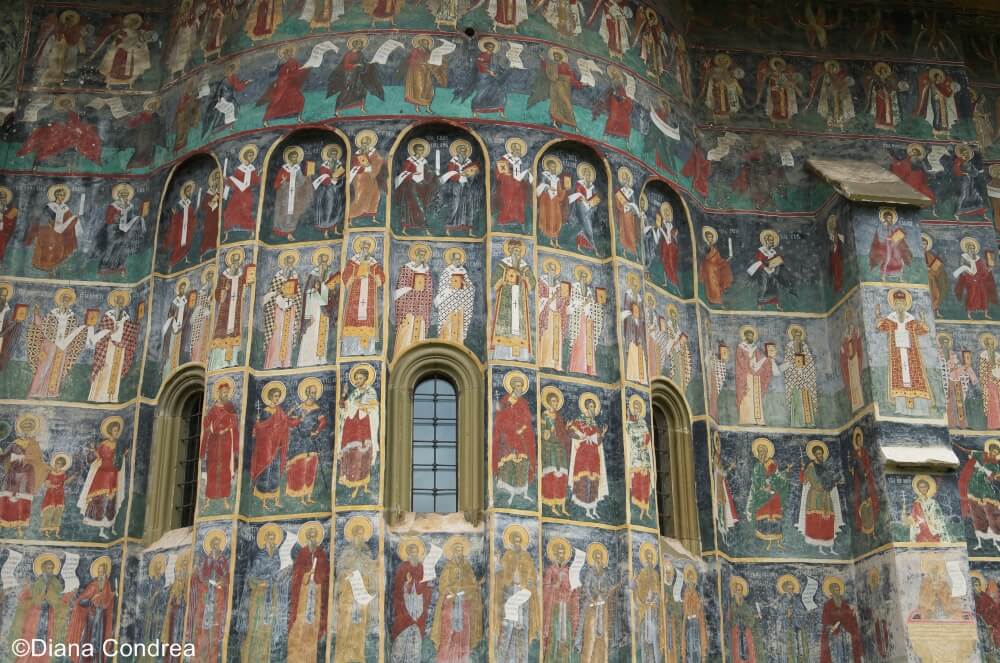
The inside has wonderful mosaics with great detail in the faces and clothes, all with a blue background and gilt stars. The iconostasis and icon frames are intricate gilt/green/red carved wood. The main icon has a large silver jacket. 5Lei (this is the only one of these monasteries that charged entrance, but the nun was not great at collecting). 3 Lei to park.
Bogdana Monastery. This monastery was being totally renovated and the church, covered in scaffolding, could not be entered. The exterior was rough stone. Even the old part of the monastery was completely torn apart but the new section was fine.
Dragomirna Monastery. This massively fortified monastery has huge buttressed walls, guard towers on the corners and a large central gate. The exterior of the church was covered in scaffold but the church itself could still be visited.

The highlight here is the tremendous height of the entire church. The first narthex is undecorated brick/stone with 5 graves. The internal narthex is plain plaster with wonderful twisted rope columns and decorative rib vaults at the apex of the domes. The reliquary of Jacob Persul, or St Mare Mucenu form 421 is in a small wood coffin. The nave is completely frescoed with bright detailed murals, has richly carved chairs, a gold/red iconostasis with 57 icons and a silver jacketed virgin icon. Free
It was a 10km drive off the highway.
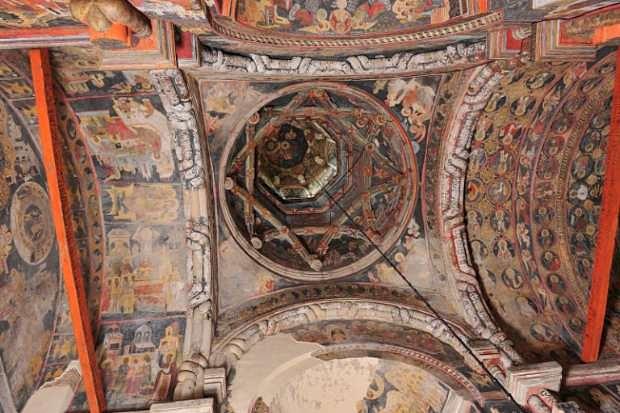
SUCEAVA
Suceava has been the capital and commercial centre of the northeast part of Romania since 1388.
Planetarium din Suceava. Operated by the university, it has great pictorial dioramas (only in Romanian) showing evolution of the universe, solar system, the sun, several galaxies and all the astronomical telescopes and observatories around the world. The shows last 45 minutes and are on the hour (also only in Romanian). 20 Lie, 10 reduced
Bucovina Museum. Presents the local history of Suceava and Moldavia with exhibits on archaeology, ethnography and history, but is only in Romanian and I didn’t learn much about Suceava. 12 Lei, no reduction
Museum of Natural Sciences. Highlights the flora and fauna of the region in wonderful dioramas, a small aquarium plus lots of rocks, including some large crystals. 6 Lei, no reduction
Saint John the New Monastery. In the center of the city and with no large wall, enter through the large guard tower. T he exterior has a very few faded murals on the west and north sides, but the highlight is the geometrics on the roof. The inside is completely frescoed and very average with the highlight the intricately carved wood iconostasis with 39 icons and 4 silver jacketed icons. Free
Bucovina Village Museum. Located near the castle, this open-air museum is designed as a traditional Bukovina village with 31 buildings: houses, a water wheel, workshops and a 1787 church in a lovely park-like setting. There is a lot of traditional furniture and dress. 6 Lei, 3 reduced
NOMAD MANIA Romania – Northeast (Iaşi, Bacău, Botoşani, Neamţ, Suceava)
World Heritage Site: Churches of Moldavia
Tentative WHS
Codrul secular Slatiora (forêt séculaire) (01/03/1991)
L’église des Trois Hiérarques de Iassy (01/03/1991)
Le Monastère de Neamt (01/03/1991)
XL: Extreme northeast (Darabani, Vorniceni areas)
Borders
Moldova-Romania
Romania-Ukraine
Railway, Metro, Funiculars, Cable Car: Romania Intercity Railway Experience
Museums
Campulung Moldovenesc: Muzeul Arta lemnului
Gura Humorului: Folk Traditions Museum of Bucovina
Religious Temples:
Agapia Monastery
Bistrița Monastery
Bogdana Monastery
Dragomirna Monastery
Humor Monastery
Moldovița Monastery
Neamț Monastery
Putna Monastery
Sucevita Monastery
Voroneț Monastery, Suceava
Modern Architecture: Buildings and Monument: Mihai Eminescu, Onesti
Festivals: Mechanical Music Fes
European Cities
PIATRA NEAMT
BACAU
Museums: Iulian Antonescu Museum
House Museums/Plantations: George Bacovia Memorial House
BOTOSANI
Railway, Metro, Funiculars, Cable Cars: Botoșani Trams
IAŞI World Cities
Railway, Metro, Funiculars, Cable Cars: Iași Trams
Museums:
Ion Creanga Museum
Mohail Kogalniceanu Museum
Natural History Museum
Unirii Museum (Unity Museum)
Castles, Palaces, Forts: Palace of Culture
Religious Temples: Trei Ierarchi Monastery (Three Holy Hierarhs Monastery)
Botanical Gardens: Botanic Garden
Malls/Department Stores: Palas Iași
Markets: Hala Centrala
Festivals:
Afterhills Music & Arts Festival
International Theatre Festival for Children and Youth
Rocanotherworld
SUCEAVA
Museums:
Bucovina Museum
Museum of Natural Sciences
Religions Temples:
Saint John the New Monastery
Planetarium: Planetarium din Suceava
Open-Air Museums: Bucovina Village Museum
Villages and Small Towns
Ciocanesti
Marginea
Plesa
